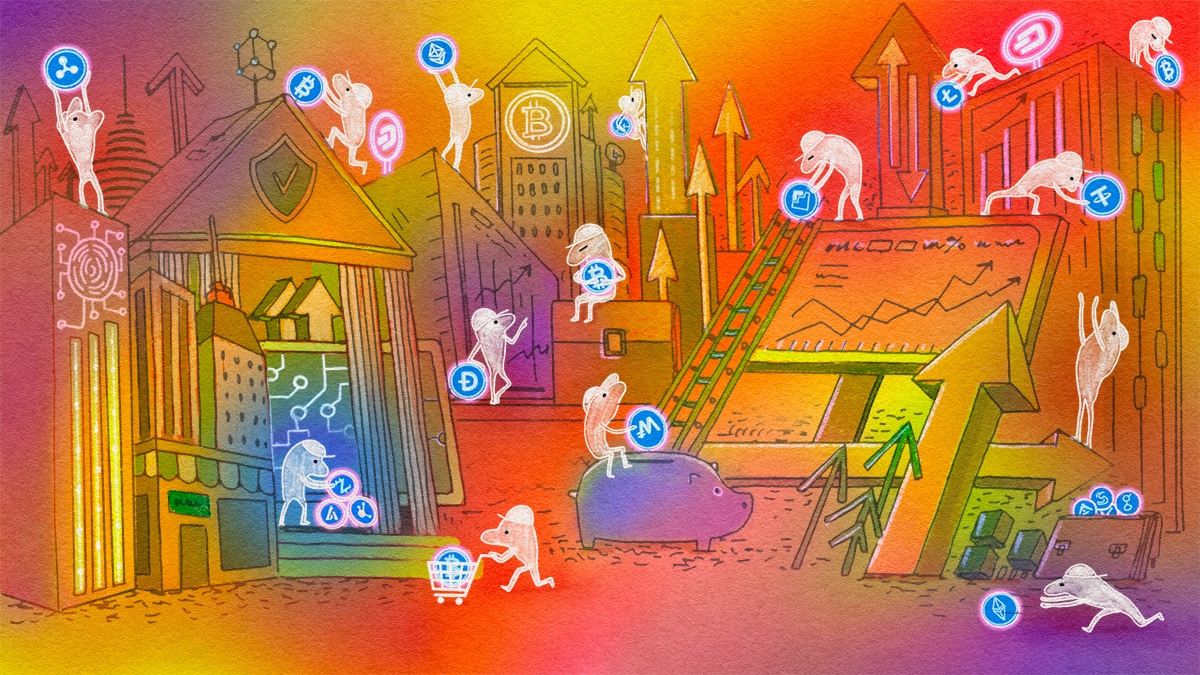After a long period of watching cryptocurrencies climb — to record highs in November 2021 — digital currencies fell dramatically. In the first half of 2022 alone, Bitcoin, the world’s largest cryptocurrency, lost over half its value. And it wasn’t the only one. Other digital currencies faced sharp losses as well.
Exhortations to invest in blockchain and cryptocurrency have been all over social media in recent years, enough that the average investor could be forgiven for wondering if they were missing out on an investment everyone and their mother seemed to be profiting from. But without understanding the risks involved, it can be difficult to know if this sector is right for your portfolio, particularly given its recent tumble. The ongoing price retracement may be an opportunity for investors to take some time to gain a better understanding of how cryptocurrencies work and decide if and how they might be a part of a diversified investment strategy.
Let’s look at some of the questions you may be too embarrassed to ask.
I know the names Bitcoin, Dogecoin and Ethereum, but what is cryptocurrency?
You wouldn’t be the first to ask. Crypto can sometimes seem a bit like a mythical animal — part currency, part commodity, part stock. In fact, regulators don’t always agree on the definition either (we’ll get to that shortly).
At its core, cryptocurrency is a medium of exchange that allows you to pay for goods and services. In this way, it’s similar to any other currency, whether it’s the Canadian dollar or Indian rupee. So, what’s different? Well for one, you can physically hold a fistful of dollars, whereas cryptocurrencies exist only in digital form. For another, physical currencies are issued by a central bank — such as the Bank of Canada or the U.S. Federal Reserve. Government institutions around the world are responsible for the issuance of their own coins and notes. But cryptocurrencies are verified and maintained through a decentralized system. That’s because digital currency uses cryptography — a technique which protects digital data by transforming it into a format that cannot be recognized by unauthorized users — to verify transactions.
In short, there is no single authority or Bank of Crypto that has a responsibility to oversee regulation. For many investors, it is precisely this lack of central oversight that creates the allure and also the risk associated with cryptocurrency.
Are crypto and blockchain the same thing?
Crypto and blockchain are not the same thing. However, we wouldn’t have any cryptocurrency without blockchain. The terms sometimes get used interchangeably, and that may be because the first popular example of blockchain technology was its use as the database for the first cryptocurrency — you guessed it — Bitcoin. (Bitcoin is to cryptocurrency what Kleenex is to tissues. There are currently more than 10,000 cryptocurrencies in circulation, but the biggest brand name is often used as a stand-in for the whole category.)
At its most basic, blockchain acts as a digital ledger: When a digital currency is used to pay for goods or services, the coin exchange is recorded over a vast decentralized network of computers. It is this decentralized network that we describe as the blockchain. The technology helps to prevent cryptocurrency owners from illicitly spending the same coin twice, something that’s not an issue with physical currency. For example, if you give a $20 bill to a store clerk to buy a pound of coffee, that bill is gone from your pocket. It is physically impossible for you to use the same $20 to buy flowers at the shop next door. In the world of cryptocurrency, blockchain records the removal of that $20 from your digital wallet so you can’t use it again.
While cryptocurrency doesn’t work without blockchain, the technology has many other potential applications. This is because blockchain can be used to encrypt, store and verify any type of digital content. It’s what gives blockchain the potential to be a technology disruptor.
Applications for blockchain technology include smart contracts and supply chain management. Businesses in the health care industry are exploring ways to use blockchain to securely store confidential patient information, and artists are looking for ways to monetize their work. When executed on a blockchain network, all kinds of transactions can become trackable, transparent and irreversible. An additional appeal for business owners? This type of automation has the potential to meaningfully boost productivity and lower business costs.
Non-fungible tokens — or NFTs as they are more commonly known — are another example of how blockchain technology is being used. The tokens represent ownership, whether it’s a unique video or a Pokémon card. Perhaps most notably, NFTs have been used to buy, sell and verify digital art. Even if the art exists and is freely available on the internet, the NFT confers official ownership, much like the difference between owning an original painting or simply a print of it. And like art, or Pokémon cards, the underlying value is not fixed. Today’s priceless NFT could be worth a small fortune or nothing at all in five years.

Reported losses to fraud associated with cryptocurrency, from 2018 to 2020

Losses reported to the Canadian Anti-Fraud Centre associated with cryptocurrency in 2021 alone.
Source: RCMP
Back to currency. If there is no mint producing Bitcoin, where does it come from?
The process of adding new bitcoins into circulation is called mining. And just as the gold miners who rushed to the Klondike in the late-1800s discovered, the process of mining can be costly, painstaking and only sporadically rewarding. Unlike gold mining, however, cryptocurrency mining involves computers racing to complete wildly complex mathematical equations.
To mine a new bitcoin, a prospector needs to be the first to come up with the correct answer to the numeric problem created by a blockchain creator. In order to arrive at the correct 64-digit hexadecimal figure (which contains both numbers and letters), the miners need a lot of computing power. This is where things start to get expensive: Not only do miners need pricey and powerful computers to do the math, a significant amount of electrical power is used to run the computers and keep them from overheating. Depending on how the electricity is generated — which could be from non-renewable resources like coal or natural gas, or renewable sources such as hydro-electricity — the environmental costs can be significant.
So cryptocurrency is mined. Does that make it a commodity like gold?
Good question. Right now, digital currency is viewed as a commodity by the Commodities and Futures Trading Commission (CFTC), as well as by the Canada Revenue Agency. However, the Securities and Exchange Commission (SEC) has declared that crypto is an investment contract and should therefore be regulated like an equity investment.
To add more uncertainty to the equation, any vendor who accepts digital coins for the purchase of goods and services is treating cryptocurrency as good as money. The CFTC and SEC are still duking it out over which group has the authority to regulate the cryptocurrency industry. As a result, companies involved in the crypto sector have very little clarity about what regulations apply to their business decisions, something that could increase the risk for investors in an already volatile investment category. Without clear regulation, there is limited protection for investors.

Is cryptocurrency a safe investment?
Here’s the thing about cryptocurrency: It has no intrinsic value. Although digital coins are increasingly accepted as a medium of exchange, their value has not been established as legal tender by government regulation. This is where the decentralized system can really bite. Without a government-backed central bank promising to purchase cryptocurrency at any time (as they do with regular currencies), there is no way to confirm crypto’s creditworthiness. While fans of digital currency may not agree, one can argue that crypto’s value comes only from people’s continued willingness to trade goods, services or other currencies for it.
One of the risks investors need to consider when evaluating cryptocurrency is related to price volatility. During the COVID-19 pandemic, thousands of investors with time on their hands discovered the excitement of speculative stock trading. Much like the tulip mania in the 1630s, investors became besotted with cryptocurrency. Between 2019 and early 2022, the global cryptocurrency market grew exponentially. However, in the second quarter of 2022, digital currency values fell sharply — wiping out at least US$1 trillion in investor value in a three-month period.
Are there other risks to consider?
Yes. There’s the risk of a scam disguised as an opportunity to invest in cryptocurrency. The U.S. Federal Trade Commission (FTC) reported that, since the beginning of 2021, more than 46,000 Americans have reported losses in crypto scams, to a total of over US$1 billion. That is 60 times more than what was reported in 2018. In Canada, the RCMP reported that investment scams tied to crypto accounted for reported losses of $12.6 million between 2018 and 2020. But in 2021, the number jumped substantially: The Canadian Anti-Fraud Centre received reports of cryptocurrency fraud losses totaling $75 million.
Among the many features that make crypto attractive to fraudsters is the lack of a centralized authority to flag suspicious transactions. This is one downside of a decentralized system. Another is that crypto transfers cannot be reversed — once the money is gone, it’s gone. That can be very appealing to bad actors.
The alchemy of social media combined with crypto fraud has spun gold for criminals globally. According to the FTC, 40% of fraud originating on social media was tied to crypto — far more than any other payment method. Of these losses, most are investment scams, but an increasing number involve so-called romance fraud, in which a criminal adopts a fake online identity to gain the victim’s affection and trust. Instead of tips on getting started with crypto investing, the target gets a tutorial on sending crypto to the criminal. In the U.S. alone, the median reported loss to a romance scam involving crypto is about US$10,000.
What are some ways to invest in crypto?
As an investor, there are three options to consider when looking at investing in digital currencies. One option might be to consider purchasing an Exchange Traded Fund (ETF) or mutual fund that focuses on the sector. Depending on the construction of the fund, it could include investments in digital currency, crypto exchanges and industries related to crypto mining.
A second option is to purchase digital currency directly through a crypto exchange or broker. In this case, an account is set up specifically to hold crypto coins, and any digital coins purchased would be held in your account.
Finally, you might consider investing in companies that could flourish as a result of digital mining. Investors sometimes refer to this as a pickaxe strategy: Not every person who joined the Klondike gold rush did well, but those who supplied pickaxes prospered, with little exposure to the high costs and risks of actually mining gold. Investing in companies that manufacture high-speed computer chips, for example, might be an alternative way to potentially benefit from a high-risk sector.
Where can I find more information on cryptocurrency?
For more perspective on the risks and opportunities associated with crypto investing, watch Brad Simpson, Chief Wealth Strategist for TD Wealth, in conversation with Kim Parlee here: Bitcoin investing: Hype or real?
Nicole Ewing, Director of Tax and Estate Planning with TD Wealth, has also shared some insights about the tax implications of crypto investing here: Cryptocurrency and your tax return.
There is an adage that wise investors “don’t take risks in companies they don’t understand.” It has been a heady year for cryptocurrency. With digital currency and blockchain valuations returning to levels last seen in 2019, it could be a good time to pause and learn the fundamentals about this sector. That way you can make informed choices about whether this is a suitable tool to help diversify your investments.





